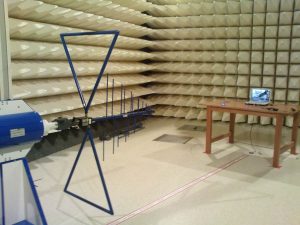Important of Radiated Emission Testing
Ege Test Center and Radiated Emission Test
Radiated Emission , in other words, by means of Radiated Propagation is only one of the Electromagnetic Compatibility (EMC) tests. According to the product to be tested according to the EMC standard is determined after determining an anechoic chamber (anechoic chamber) or in the open field test area (OATS) is a test must be done. The purpose of the Radiated Emission test is to determine whether the unwanted electromagnetic frequencies of the product are below a certain level. Radiated EmissionIf the measurement results of a product being tested are below the limit values specified in the relevant standard, this test is considered to have passed. If the measurements on the limit are obtained, a change in design or EMC is required on the remaining product. The studies carried out on this kind of product are R & D studies and are very important works for the producer.

What You Need to Know About Radiated Emission Test
The measured frequency range of the Radiated Emission tests usually starts at 30 MHz and can be up to 1GHz, 2GHz or 6GHz depending on the product specification and the applied standard. Measurements are made with the antennas designed for the specified frequencies and the measurement devices called the EMI Receiver. The measuring distance between the product and the antenna is usually 3 meters or 10 meters. It is also possible to change the limits according to the measuring distance. For example, the limit value of 40 dBuV / m at 3 m can be reduced to 30 dBuV / m if the measurement is done at 10 m.
The Radiated Emission test is one of the most basic tests of EMC tests, so it is a test that the product designers should be familiar with. Measures related to EMC testing of a product should start at the design stage of the product and continue during the serial production phase. Even when the product is in the end user, it should be followed.


 Radiated Emission is only one of the Electromagnetic Compatibility (EMC) tests. It is a test that must be performed in an anechoic chamber or Open Area Test Site (OATS) after the EMC standard has been determined. This standard has to be determined according to the product. Radiated Emission testing is to determine whether the intended product is below a certain level of unwanted electromagnetic frequencies. If the measurement results of a product is under the limit value stated on the standard, this test is counted as PASS. If measurements exceed the limit, it is necessary to make improvements on the product in terms of design change or EMC. The work done on this kind of product is R & D work and it is very essential for manufacturers.
Radiated Emission is only one of the Electromagnetic Compatibility (EMC) tests. It is a test that must be performed in an anechoic chamber or Open Area Test Site (OATS) after the EMC standard has been determined. This standard has to be determined according to the product. Radiated Emission testing is to determine whether the intended product is below a certain level of unwanted electromagnetic frequencies. If the measurement results of a product is under the limit value stated on the standard, this test is counted as PASS. If measurements exceed the limit, it is necessary to make improvements on the product in terms of design change or EMC. The work done on this kind of product is R & D work and it is very essential for manufacturers.